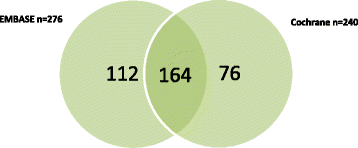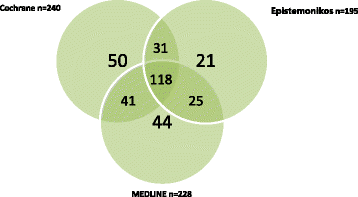A comparison of the performance of seven key bibliographic databases in identifying all relevant systematic reviews of interventions for hypertension
- PMID: 26862061
- PMCID: PMC4748526
- DOI: 10.1186/s13643-016-0197-5
A comparison of the performance of seven key bibliographic databases in identifying all relevant systematic reviews of interventions for hypertension
Abstract
Background: Bibliographic databases are the primary resource for identifying systematic reviews of health care interventions. Reliable retrieval of systematic reviews depends on the scope of indexing used by database providers. Therefore, searching one database may be insufficient, but it is unclear how many need to be searched. We sought to evaluate the performance of seven major bibliographic databases for the identification of systematic reviews for hypertension.
Methods: We searched seven databases (Cochrane library, Database of Abstracts of Reviews of Effects (DARE), Excerpta Medica Database (EMBASE), Epistemonikos, Medical Literature Analysis and Retrieval System Online (MEDLINE), PubMed Health and Turning Research Into Practice (TRIP)) from 2003 to 2015 for systematic reviews of any intervention for hypertension. Citations retrieved were screened for relevance, coded and checked for screening consistency using a fuzzy text matching query. The performance of each database was assessed by calculating its sensitivity, precision, the number of missed reviews and the number of unique records retrieved.
Results: Four hundred systematic reviews were identified for inclusion from 11,381 citations retrieved from seven databases. No single database identified all the retrieved systematic reviews for hypertension. EMBASE identified the most reviews (sensitivity 69 %) but also retrieved the most irrelevant citations with 7.2 % precision (Pr). The sensitivity of the Cochrane library was 60 %, DARE 57 %, MEDLINE 57 %, PubMed Health 53 %, Epistemonikos 49 % and TRIP 33 %. EMBASE contained the highest number of unique records (n = 43). The Cochrane library identified seven unique records and had the highest precision (Pr = 30 %), followed by Epistemonikos (n = 2, Pr = 19 %). No unique records were found in PubMed Health (Pr = 24 %) DARE (Pr = 21 %), TRIP (Pr = 10 %) or MEDLINE (Pr = 10 %). Searching EMBASE and the Cochrane library identified 88 % of all systematic reviews in the reference set, and searching the freely available databases (Cochrane, Epistemonikos, MEDLINE) identified 83 % of all the reviews. The databases were re-analysed after systematic reviews of non-conventional interventions (e.g. yoga, acupuncture) were removed. Similarly, no database identified all the retrieved systematic reviews. EMBASE identified the most relevant systematic reviews (sensitivity 73 %) but also retrieved the most irrelevant citations with Pr = 5 %. The sensitivity of the Cochrane database was 62 %, followed by MEDLINE (60 %), DARE (55 %), PubMed Health (54 %), Epistemonikos (50 %) and TRIP (31 %). The precision of the Cochrane library was the highest (20 %), followed by PubMed Health (Pr = 16 %), DARE (Pr = 13 %), Epistemonikos (Pr = 12 %), MEDLINE (Pr = 6 %), TRIP (Pr = 6 %) and EMBASE (Pr = 5 %). EMBASE contained the most unique records (n = 34). The Cochrane library identified seven unique records. The other databases held no unique records.
Conclusions: The coverage of bibliographic databases varies considerably due to differences in their scope and content. Researchers wishing to identify systematic reviews should not rely on one database but search multiple databases.
Figures



Similar articles
-
Search strategies to identify diagnostic accuracy studies in MEDLINE and EMBASE.Cochrane Database Syst Rev. 2013 Sep 11;2013(9):MR000022. doi: 10.1002/14651858.MR000022.pub3. Cochrane Database Syst Rev. 2013. PMID: 24022476 Free PMC article. Review.
-
Cochrane systematic reviews in acupuncture: methodological diversity in database searching.J Altern Complement Med. 2005 Aug;11(4):719-22. doi: 10.1089/acm.2005.11.719. J Altern Complement Med. 2005. PMID: 16131298 Review.
-
Comparing the coverage, recall, and precision of searches for 120 systematic reviews in Embase, MEDLINE, and Google Scholar: a prospective study.Syst Rev. 2016 Mar 1;5:39. doi: 10.1186/s13643-016-0215-7. Syst Rev. 2016. PMID: 26932789 Free PMC article.
-
Identifying systematic reviews of the adverse effects of health care interventions.BMC Med Res Methodol. 2006 May 8;6:22. doi: 10.1186/1471-2288-6-22. BMC Med Res Methodol. 2006. PMID: 16681854 Free PMC article.
-
Literature searching for clinical and cost-effectiveness studies used in health technology assessment reports carried out for the National Institute for Clinical Excellence appraisal system.Health Technol Assess. 2003;7(34):iii, ix-x, 1-51. doi: 10.3310/hta7340. Health Technol Assess. 2003. PMID: 14609481 Review.
Cited by
-
Multimodal cognitive and behavioral interventions for patients with MCI: a systematic review and meta-analysis on cognition and mood.Front Aging Neurosci. 2024 Apr 30;16:1390699. doi: 10.3389/fnagi.2024.1390699. eCollection 2024. Front Aging Neurosci. 2024. PMID: 38746830 Free PMC article.
-
Use of a search summary table to improve systematic review search methods, results, and efficiency.J Med Libr Assoc. 2021 Jan 1;109(1):97-106. doi: 10.5195/jmla.2021.809. J Med Libr Assoc. 2021. PMID: 33424470 Free PMC article.
-
Searching for studies: A guide to information retrieval for Campbell systematic reviews.Campbell Syst Rev. 2024 Sep 10;20(3):e1433. doi: 10.1002/cl2.1433. eCollection 2024 Sep. Campbell Syst Rev. 2024. PMID: 39258215 Free PMC article.
-
Foot health in patients with rheumatoid arthritis-a scoping review.Rheumatol Int. 2017 Sep;37(9):1413-1422. doi: 10.1007/s00296-017-3699-0. Epub 2017 Mar 21. Rheumatol Int. 2017. PMID: 28324133
-
Comparison of Reporting and Transparency in Published Protocols and Publications in Umbrella Reviews: Scoping Review.J Med Internet Res. 2023 Aug 2;25:e43299. doi: 10.2196/43299. J Med Internet Res. 2023. PMID: 37531172 Free PMC article.
References
-
- Oxford Centre for Evidence-Based Medicine—levels of evidence [http://www.cebm.net/oxford-centre-evidence-based-medicine-levels-evidenc...] Accessed 23-01-2015.
Publication types
MeSH terms
LinkOut - more resources
Full Text Sources
Other Literature Sources
Medical
Research Materials

